
Although the daguerreotype process process was largely discarded in the mid-1860s, overtaken by the development of other photographic techniques, it has seen something of a revival in recent years.
(pr. duh-gayr"oh-type')
Some examples:
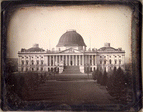
John Plumbe, Jr. (American, 1809-1857) photographer,
United States Capitol, Washington, D.C.,
east front elevation, half
plate daguerreotype, c. 1846, Library of Congress, Washington,
DC. Plumbe was one of the first photographers in the United States,
taking up the practice very shortly after Samuel F.B. Morse brought
the idea from France in 1839. One of the earliest surviving photographs
of the Capitol, Plumbe's picture of the capitol records its old
copper-sheathed wooden dome.

Albert Sands Southworth (American, 1811-1894)
and Josiah Johnson Hawes (American, 1808-1901), Lemuel Shaw, c. 1850, daguerreotype,
21.6 x 16.5 cm (8 1/2 x 6 1/2 inches), Metropolitan Museum of
Art, NY.
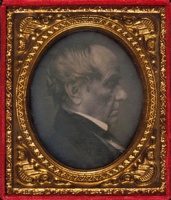
Albert Sands Southworth and Josiah Johnson Hawes, Daniel Webster (1782-1852), April 22, 1850, daguerreotype, Hood Museum of Art, Dartmouth College, NH.

Louis-Auguste Bisson (French, 1814-1876),
Cleveland, c. 1842-1843, daguerreotype,
Cleveland Museum of Art.
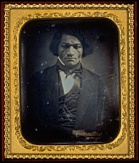
Unidentified Artist, Frederick Douglass (1818-1895), c. 1850, daguerreotype, image: 8 x 6.9cm (3 1/8 x 2 11/16 inches); case open: 9.5 x 16.8 x 1.3 cm (3 3/4 x 6 5/8 x 1/2 inches), National Portrait Gallery, Washington, DC.

Samuel Root (American, 1819-1889) and Marcus Aurelius Root (American, 1808 - 1888), P.T. Barnum and General Tom Thumb (Phineas Taylor Barnum, 1810-1891, Charles Sherwood Stratton, 1838-1883), c. 1850, daguerreotype; case open: 15.4 x 24.8 x 1.3 cm (6 1/16 x 9 3/4 x 1/2 inches), National Portrait Gallery, Washington, DC.

John Adams Whipple (American, 1822-1891),
Cornelius Conway Felton with His Hat and Coat,
early 1850s, daguerreotype, visible: 8.3 x 7 cm (3 1/4 x 2 3/4
inches) each, Metropolitan Museum of Art, NY. See diptych.

Mathew Brady (American, 1823-1896) Studio,
Thomas Cole (1801-1848), c. 1846, daguerreotype,
5 3/8 x 4 inches (13.6 x 10.2 cm), National Portrait Gallery,
Smithsonian Institution, Washington, DC. See examples of Thomas
Cole's paintings at allegory
and landscape.
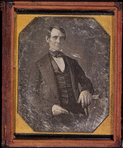
Nicholas H. Shepherd (American), Abraham Lincoln, three-quarters length
portrait, seated, facing front, quarter plate daguerreotype,
1846 or 1847, Library of Congress, Washington, DC. This daguerreotype
of Lincoln is the earliest known portrait of the 16th president
of the United States. It was most likely taken in Springfield,
Illinois, shortly after Lincoln was first elected to the House
of Representatives. See a higher resolution JPEG version (233 k) or
an archival TIFF version (4 meg).
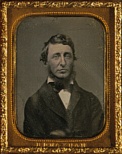
Benjamin D. Maxham (American, active 1848-1858), Henry David Thoreau (1817-1862), 1856,
daguerreotype;
image: 6.3 x 4.7cm (2 1/2 x 1 7/8 inches); case open: 7.8 x 12.7 x 1.3 cm (3 1/16 x 5 x 1/2 inches), National Portrait Gallery, Smithsonian Institution, Washington, DC. See transcendentalism.
![]()
Unknown American, Edgar Allan Poe, Lowell, Massachusetts,
late May - early June 1849, daguerreotype, image: 4 13/16 x 3
1/2 inches (12.2 x 8.9 cm), J. Paul Getty Museum, Malibu, CA.
Mathew Brady, Martin Van Buren (1782-1862), 8th president of the US (1837-1841), daguerreotype, c. 1856, National Portrait Gallery, Washington, DC.

American, Salisbury House, Worcester, Massachusetts,
c. 1857, daguerreotype, Worcester Art Museum, MA.
https://inform.quest/_art
Copyright © 1996-![]()